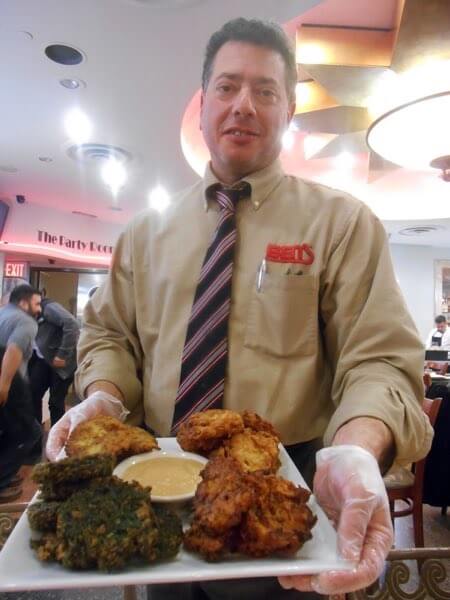By Merle Exit
Hanukkah… or Chanukah (we have been wandering for many years in search of the correct spelling) is the winter holiday commemorating the restoration of Jewish worship at the temple of Jerusalem when Judah Maccabee led the revolt against the Seleucid Empire in 164 BCE. Judah was called “Maccabee,” a word composed of the initial letters of the four Hebrew words “Mi Kamocha Ba’eilim Hashem,” meaning: “Who is like You, G-d.”
Having conquered, Maccabee obtained a menorah to serve as a memorial. A small amount of olive oil was used, and expected to burn for one day. Instead, the menorah burned for eight days, and to remember this miaracle, this Hebrew year of 5777, Chanukah begins on the evening of the 24th of December (Kislev).
With the exception of the High Holy Days, Jewish holidays tend to follow the same pattern: We fought, we won, we eat. Which traditional foods are served on this Hanukkah? Think of it as consuming the eight days of oil—starting with fried pancakes called “latkes.”
Most common are the potato latkes that combine raw grated potatoes with onions, eggs, and flour (or matzo meal), a traditional Ashkenazi classic. Why do we grate the potatoes? To remind us of our suffering, of course! You can certainly bake them, but it tastes so much better fried in oil.
Let’s go to our matzo maven Hal Simon, general manager of Ben’s Kosher Deli in Bay Terrace, who started working there at the age of 16 at its first location in Carle Place, L.I. He tells me that latkes are always made with potatoes. However, they can be prepared with other added vegetables such as zucchini, spinach or sweet potato. Looking at other countries’ ideas shows that Israelis, for instance, make theirs using meat. Great for those “meat and potato “ lovers.
Another tradition is “kugel,” or pudding using either potatoes or wide noodles (“lokshon”). Potato kugel is like having a huge baked latke. Noodle pudding is prepared two ways: sweet or savory. The savory version combines noodles, eggs, cottage cheese, sour cream, and butter. Oy, the cholester-oil! Butter makes the noodles crunchy along the bottom. One sweet version uses less butter and adds sugar, nutmeg, cinnamon and raisins, usually served cold.
It was Herbert Hoover who suupposedly promised “a chicken in every pot,” but Ben’s took it seriously. Half of a boiled chicken, noodles, a large matzo ball, peas, carrots, and meat “kreplach” (dumplings) are actually served in a pot. Ben’s cures their tongue and corned beef on the premises.
“It takes two weeks to do this”, Hal said.
Then, of course, there’s brisket (uncured corned beef), pastrami and turkey. But don’t kvetch if you find that the food isn’t salty enough—Hal says that you can always add salt.
Ben’s does have desserts of pastries and a few other goodies, but not “sufganiyah” (fried jelly donuts). According to Gil Marks, author of “The Encyclopedia of Jewish Food,” Polish immigrants brought “ponchiks,” as they called them, to Israel along with the custom of eating them on Hanukkah. In Israel, however, ponchiks soon took the name sufganiyah (sufganiyot plural), from a “spongy dough” mentioned in the Talmud, “sofgan” and “sfogga.”
In 2009, about 18 million sufganiyot were consumed in Israel in the weeks before and during the holiday, or about three doughnuts per Israeli, with the Isreali Defense Force alone purchasing around a half million that year. About 70 percent of all sufganiyot consumed are stuffed with jelly, but a number of other fillings have become popular, including halva, crème espresso, chocolate truffle, and numerous exotic flavors. Jelly doughnuts in Brazil are commonly filled with dulce de leche (a milky caramel), which recently also became a popular Israeli filling, known as “ribat chalav” in Hebrew. American Jews have adopted the sufganiyah, although most tend to stick to the old- fashioned jelly fillings and a confectioners’ sugar dusting.
I got some latkes to go to make your own noodle pudding at home. Noticing that I did not have anything similar to cottage cheese, I made my own using whole milk. I heated it up to an almost boil and dropped in some fresh lemon juice. Cheese goes to the top, whey to the bottom. Drain through a cloth, and now you have fresh cheese.
Fish, particularly salmon, is neutral or “pareve.” A combo of smoked salmon, chopped hard boiled eggs, capers, chopped onions and tomato would suffice as an appetizer. In fact, you can have that, schmooze with your friends or family for an hour, and then indulge in Ben’s traditional delights.
Back to Hal, who told me that Chinese restaurants aren’t the only ones open on Christmas Day. Although the restaurant is considered to be kosher, they are not closed on the Sabbath. That means that you can dine there on the first day of Hanukkah. Check the website for specials that may have nothing to do with the holiday. Hey, you don’t have to be Jewish to love latkes—all year round.
(correcting story to say Ben’s Kosher Deli in Bay Terrace)

































